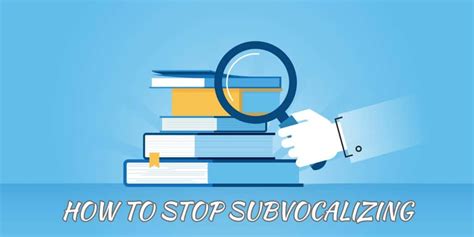Introduction

Subvocalization, commonly known as inner speech, is the silent articulation of words and sentences in the mind. While it is a natural phenomenon, excessive subvocalization can hinder reading comprehension, concentration, and overall cognitive performance. This guide provides a comprehensive approach to effectively stop subvocalizing, empowering you to enhance your cognitive abilities and reach your full potential.
Understanding Subvocalization
Subvocalization occurs when the brain’s language center activates the muscles responsible for speech, leading to the silent formation of words. This process, which is often subconscious, consumes energy and can distract the mind from external stimuli. Research indicates that approximately 80% of individuals engage in subvocalization while reading, which can significantly impact reading speed and comprehension.
Negative Impacts of Subvocalization
Excessive subvocalization has several detrimental effects on cognitive functioning:
- Reduced Reading Speed: The silent articulation of words slows down the reading process, making it difficult to keep up with the flow of the text.
- Impaired Comprehension: Subvocalization draws attention away from the meaning of the text, hindering comprehension and memory retention.
- Cognitive Overload: The constant formation of words places strain on the brain’s working memory, reducing its capacity for other tasks.
- Difficulty Concentrating: The distracting nature of subvocalization can make it challenging to focus on external stimuli, affecting attention and concentration.
Benefits of Stopping Subvocalization
Eliminating subvocalization offers numerous cognitive benefits:
- Enhanced Reading Speed: By suppressing the silent articulation of words, reading becomes smoother and faster, improving text comprehension.
- Improved Comprehension: Focusing solely on the meaning of the text improves understanding and facilitates memory retention.
- Increased Cognitive Capacity: Reducing subvocalization frees up the brain’s working memory, allowing for more efficient thinking and problem-solving.
- Improved Concentration: Eliminating distracting inner speech enhances attention and focus, enabling greater clarity and focus on external tasks.
How to Stop Subvocalizing
Stopping subvocalization requires a conscious effort and consistent practice. Here is a comprehensive approach:
- Awareness and Mindfulness: Begin by observing your subvocalization during reading and other activities. Notice the silent formation of words and the associated distraction.
- Relax Your Speech Muscles: Engage in exercises that relax the muscles responsible for speech, such as humming, chewing gum, or lightly touching your tongue to the roof of your mouth.
- Use a Pacifier: Sucking on a small object like a straw or a mint can help suppress the urge to subvocalize by physically hindering speech muscle movements.
- Focus on Comprehension: Deliberately shift your attention from the words themselves to the meaning of the text. Ask yourself questions about the content and actively engage in理解.
- Use Visual Aids: Utilize physical cues to support your reading, such as a finger or a pen to guide your eyes through the text. This helps anchor your attention to the visual words and reduces subvocalization.
- Speed Reading Techniques: Practice speed reading techniques, which focus on rapid eye movements and chunking of text, minimizing the opportunity for subvocalization.
- Cognitive Training: Engage in cognitive training exercises that challenge your working memory and注意力. This helps strengthen the brain’s ability to suppress subvocalization.
Tips for Success
- Consistency: Practice regularly to develop a new habit.
- Patience: It takes time and effort to stop subvocalizing effectively.
- Identify Triggers: Determine situations or activities that trigger subvocalization and develop strategies to manage them.
- Reward Your Progress: Acknowledge and celebrate your successes to reinforce your efforts.
Conclusion
Subvocalization can be a significant obstacle to cognitive performance. By understanding its negative impacts and implementing the techniques outlined in this guide, you can effectively stop subvocalizing and unlock your full cognitive potential. Enhanced reading speed, improved comprehension, increased cognitive capacity, and improved concentration are just a few of the benefits you can experience by embracing the silence within.
